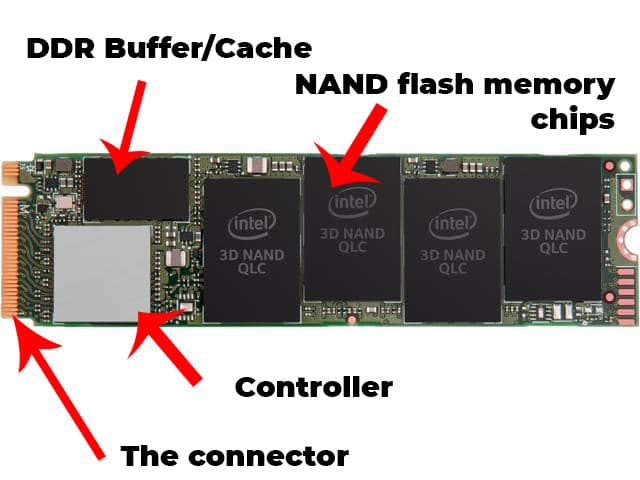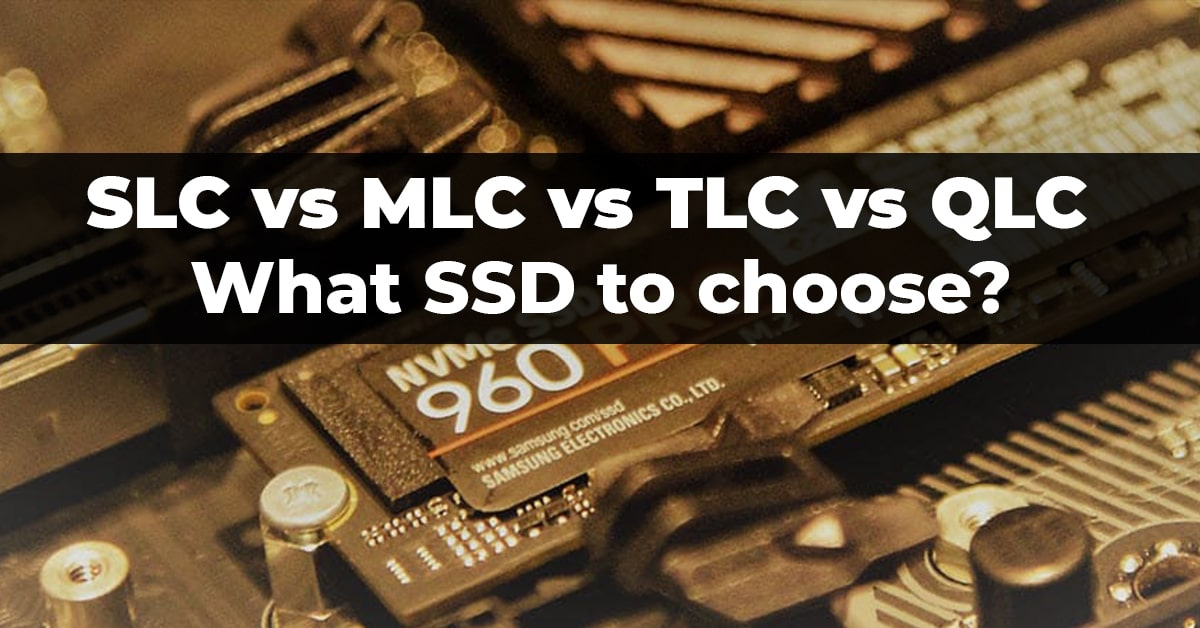In this blog, we are going to compare MLC vs TLC vs QLC. When people buy an SSD drive for home use. They might across many different things like the type of memory used and wonder which is better. MLC or TLC (In this you will come across other memory type designations like V-NAND or 3D NAND). QLC memory is also a recent and attractive-priced type of memory.

In the beginner review, the details include different types of flash memory used in SSDs. Their disadvantage and advantage and which option can be suited to a person while buying an SSD card. It can be very useful: SSD configuration for Windows 10. So, without wasting any more time let’s jump into action.
Also Read: Ryzen naming scheme: Everything you need to know
A Brief About SSD Drive: MLC vs TLC vs QLC
Apart from the fancy case connectors and stickers, an SSD has 3 major components:
- DDR Memory

Here is where your data resides. In blocks of non-violate memory. This means it does not need the power to store data. That means it does not need power.
DDR Memory: Small but volatile and not present on all SSD’s. It is used as a cache to speed up frequently accessed data.
The Controller: The mail connector between the NAND chips and your PC. The “CPU of the SSD” if you want to put it like that.
What is NAND flash memory?
This is the newest type of data storage, faster than the good old HDD. It’s also a lot more efficient.
A NAND flash chip is made up of several cells that hold bits in them. A NAND flash chip is made up of several cells that hold in them. These bits are turned on or off electrical impulse. The ordering of the cells inside the NAND flash chip represents the way data is stored on the SSD. The number of bits in each cell gives out the name of the NAND flash chip. For example, SLC comes from a Single-Level Cell and it means that each cell holds 1 bit.
Here is how we have them:
- QLC – Quad Level Cells, 4 bits per cell
- MLC – Multi-Level Cell, 2 bits per cell
- TLC – Triple Level Cell, 3 bits per cell
- SLC – Single Level Cell, 1 bit per cell
So, you ask why is this? By storing more bits in each cell. The NAND chip can hold more data. This will allow you to have bigger SSD’s. But first, remember there are also drawbacks.
And let’s explore each type of NAND chip. Don’t forget to pick an SSD by taking note of what you will be using the PC you are installing it to. Don’t senselessly burn the budget but don’t be too cheap when it’s not the case.
How afraid should i be when it comes to TBW– Total bytes written?
Let’s say we are not that afraid. Let’s say your 1TB SSD has a 300TB TBW rating. So, we can say that it can be re-written 300 times easily. If we provide you with an example an average human being rarely shut down their PC after 10-12 hours of usage. But on average they have 21TB of space on it. Which means it should probably last 14 years. So, the question arises that will this SSD will please you in 2025? You will probably want newer and bigger tech. So, we would just choose a reputable brand with a decent TBW rating that has a solid performance.
Single Level Cell — SLC NAND
This is one of the most important types of NAND memory when it comes to reading and writing data. It also has the biggest lifetime.
There are different types of SLC chips that can take up to 100.000 complete rewrites. That means it can be written up to 100.000 of its capacity. Take note that SLC’s are usually meant for enterprise stuff. These are the most expensive type out there in the market.
Pros:
- Firstly, fastest and the most precise/accurate.
- Lastly, Good lifespan- up to 100.000 TBW
Cons:
- Firstly, it is very expensive.
- Not all the big capacity wise. You probably won’t find 2 TB SLC SSD’s.
Multi-Level Cell –MLC
MLC stores 2 bits per cell. What it does is lower the production cost and also the bigger capacity. These are lower SSD prices when comparing to SLC ones. We would choose an MLC SSD as the main drive if you are hungry for performance and need peace of mind for your data. Even if in the most normal usage scenarios it won’t be so different from a TLC SSD.
Pros:
- Firstly, it is very cheaper than SLC drives.
- Secondly, more stable than TLC.
- Good Performance.
Cons:
- Well, it is not up to the SLC level of durability. Again, if you are not upgrading some enterprise hardware. We think you shouldn’t about this.
Triple Level Cell — TLC
TLC even brings out even costs but at the price of performance and durability. In a cell in a TLC NAND, a flash chip can take about 3000-5000 rewrites. We can say that it is still a lot but these drives are not meant for enterprise users as they are consumer usage and as they are consumer-grade chips.
We would choose a TLC SSD as an OS drive if you are inclining towards the budget side but I think it’s great for storing stuff. Data, Games, and movies, etc. I usually go with a TLC for NAS setups that do not see deletions too much. Or as a secondary drive on a gaming/work PC.
Pros:
- Big
- Cheap
- Not that slow
Cons:
- Slower than SLC and MLC
- Lower durability vs SLC or MLC
- Lastly, some drives get slow once filled up. You need to look for a reputable brand. Also, don’t try to choose the low-end models to avoid this.
Quad Level Cell- QLC
This is the cheapest of them all. But still, the QLC and also especially the 3D NAND QLC are much faster than the old HDD.
You need to be sure to pick a 3D NAND drive if you are going for QLC one. 3D NAND solved a lot of reliability issues with these drives.

Conclusion:
In this blog, we talked about MLC vs TLC vs QLC. Everything you need to know can be found in this blog. Thank you for the read. Hope you find this information useful.
